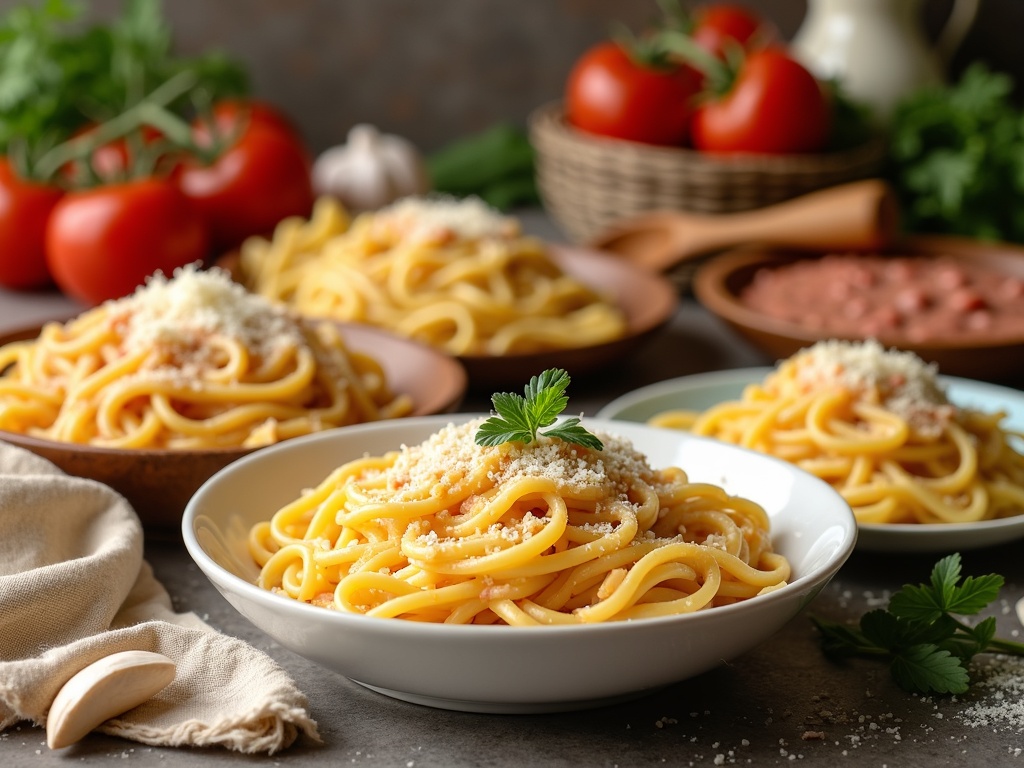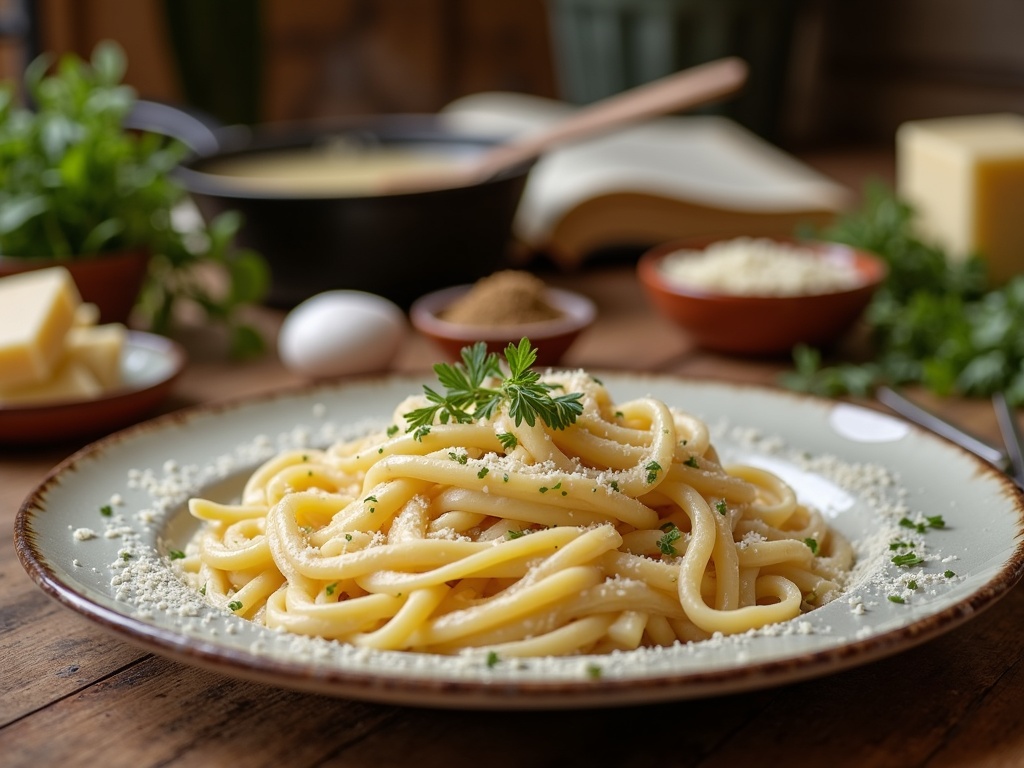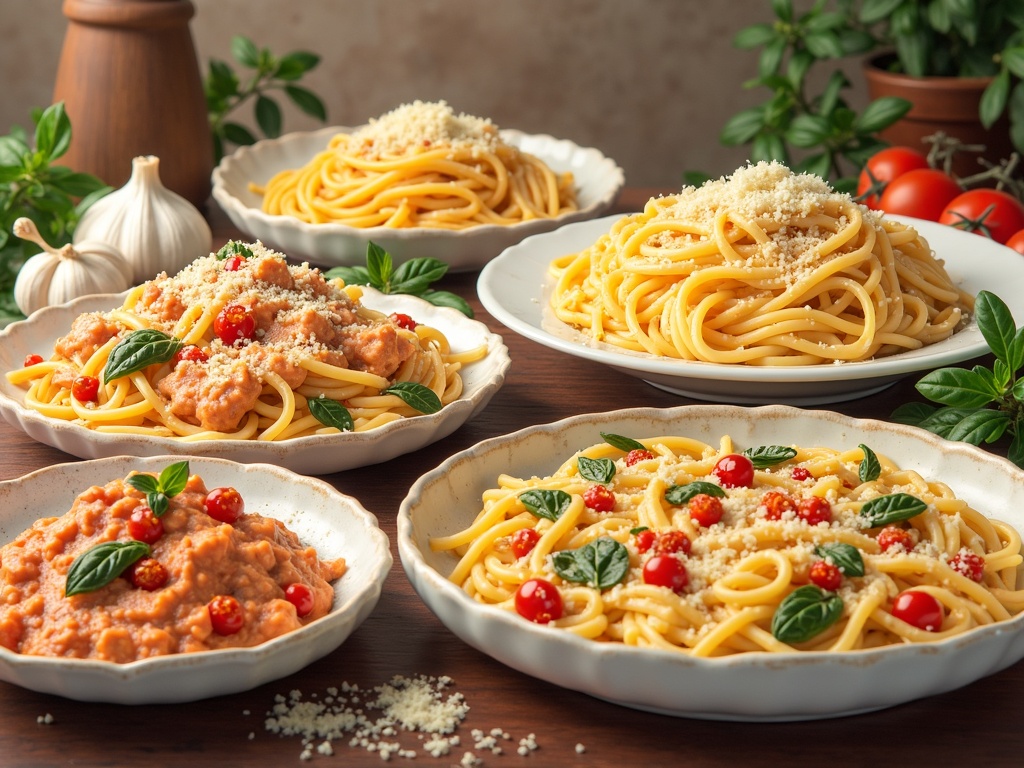Creamy pasta dishes offer the perfect balance of comfort and sophistication, with variations ranging from decadent Fettuccine Alfredo to the egg-based silkiness of Carbonara. These versatile recipes can be adapted for both special occasions and weeknight dinners, providing rich flavors and textures that have made them beloved staples in kitchens worldwide.
Find In This Article
Key Takeaways
- The classic creamy pasta contenders include Fettuccine Alfredo (600 calories per serving), Carbonara (400 calories), and Penne alla Vodka, each with distinct approaches to achieving creamy textures.
- Healthier versions can be created using Greek yogurt or cashew cream instead of heavy cream, cutting calories nearly in half while maintaining satisfying textures.
- Pasta shape significantly impacts sauce retention—fettuccine, penne, and rigatoni are particularly effective at capturing creamy sauces due to their surface textures and shapes.
- Chef-level techniques like using reserved pasta water, managing temperature carefully, and proper timing when combining pasta with sauce are crucial for silky-smooth results.
- Homemade creamy pasta dishes cost approximately $4-7 per serving compared to $16-22 for restaurant versions, offering significant savings without sacrificing quality.
Most Popular Creamy Pasta Variations You Should Try
Creamy pasta dishes always seem to hit the spot, whether I’m cooking for a dinner party or just treating myself on a weeknight. The silky textures, rich flavors, and versatile nature of these dishes make them favorites in kitchens worldwide. Let me share some of the most beloved creamy pasta variations that deserve a spot in your recipe collection.
Classic Creamy Contenders
Fettuccine Alfredo stands as perhaps the most decadent of all creamy pasta dishes, clocking in at approximately 600 calories per serving. This Italian-American classic achieves its luxurious texture through a simple yet effective combination of butter, heavy cream, and freshly grated Parmesan cheese. For the perfect Alfredo, I typically use a ratio of 1 cup heavy cream, 4 tablespoons of butter, and about 1.5 cups of finely grated Parmesan for four servings. The secret lies in emulsifying these ingredients while tossing the hot pasta, creating that signature velvety coating that clings to each strand of fettuccine. For a lighter yet equally satisfying option, you might want to try white sauce pasta which offers a similar creamy profile.
Carbonara offers a different approach to creaminess, coming in at a slightly more modest 400 calories per serving. Unlike Alfredo, Carbonara’s silkiness comes not from cream but from eggs. Traditional recipes call for whole eggs and egg yolks (typically one whole egg plus one or two yolks per serving), hard cheese like Pecorino Romano or Parmesan (about 1 cup for four servings), and cured meat. The magic happens when hot pasta meets the egg mixture—the residual heat gently cooks the eggs into a custardy sauce without scrambling them. This technique requires some finesse but delivers incredible results when mastered.
Penne alla Vodka represents yet another approach to creamy pasta perfection. This rose-colored delight combines tomato sauce with heavy cream, creating a beautifully balanced sauce that’s neither too rich nor too acidic. The vodka element might seem surprising, but it actually helps release flavors in the tomatoes that are alcohol-soluble while mostly cooking off during preparation. For those looking to incorporate vegetables into their creamy pasta dishes, broccoli pasta provides a nutritious twist that still delivers on creaminess.
Recipe trends show interesting patterns in our collective cravings. There’s a 40% increase in views for creamy shrimp pasta variations during festive seasons, suggesting these dishes have become holiday favorites for many families.
For those seeking Mediterranean flavors with a creamy twist, I highly recommend exploring puttanesca sauce with a splash of cream added. The briny, umami flavors of the traditional sauce gain an extra dimension of richness that works beautifully with pasta shapes that catch the sauce, like fusilli or orecchiette.
When I’m looking to create a heartier meal, chicken lasagna offers layers of creamy goodness combined with protein, making it perfect for family gatherings. Similarly, adding cream to a traditional bolognese sauce creates a richer version that’s become increasingly popular in recent years.
For those who enjoy bold flavors alongside creaminess, the punchy ingredients in a modified puttanesca recipe with added cream create a memorable pasta dish that balances richness with vibrant Mediterranean flavors.
Each of these creamy pasta variations offers its own unique charm and flavor profile. I find they’re all worth mastering as they provide reliable options for different occasions, from quick weeknight dinners to special celebrations where comfort food is called for.

Make Your Creamy Pasta Healthier Without Sacrificing Taste
Many of us struggle with making healthier food choices while still enjoying our favorite comfort foods. Traditional Fettuccine Alfredo packs a whopping 30 grams of fat per serving – that’s nearly half the recommended daily fat intake for most adults. But I’ve discovered some clever ways to create creamy pasta dishes that are lighter yet still wonderfully satisfying.
Smart Substitutions and Additions
Greek yogurt has become my go-to replacement for heavy cream in pasta sauces. This protein-rich alternative cuts the fat content dramatically while maintaining that silky texture we all love. For a dairy-free option, cashew cream works beautifully – just soak raw cashews overnight, blend them with water, and you’ve got a luxurious base for any creamy sauce.
Portion control also plays a crucial role in making pasta dishes healthier. I recommend using the “fist method” – a serving of pasta should be about the size of your fist, which typically equals about 1 cup of cooked pasta. This simple adjustment can significantly reduce calorie intake without leaving you feeling deprived.
Adding vegetables is another fantastic way to boost nutrition while cutting calories. I love mixing in spinach, which wilts perfectly into hot pasta, or adding steamed broccoli pasta for extra fiber and vitamins. Green peas also add a delightful sweetness and protein boost to dishes like white sauce pasta.
The numbers speak for themselves. A traditional creamy pasta dish might contain 800-1000 calories per serving, while a lightened version using Greek yogurt and added vegetables can clock in at just 400-500 calories. That’s a significant difference that can impact your health over time.
For those concerned about weight management, making these adjustments matters. Regular consumption of traditional high-fat pasta dishes has been linked to weight gain, but incorporating these healthier versions allows you to enjoy your favorite meals without sabotaging your health goals.
I’ve found that these lighter versions can be just as satisfying as their heavier counterparts. In fact, many of my friends prefer the brighter flavor of a Bolognese sauce recipe that’s been lightened up with extra vegetables and leaner proteins. You might even discover new favorite combinations, like a creamy puttanesca sauce made with Greek yogurt and extra tomatoes for acidity.

Perfect Pasta Shapes for Maximum Creaminess
Choosing the right pasta shape makes a genuine difference in how creamy your dish turns out. In fact, research indicates that selecting the optimal pasta shape can improve sauce retention by up to 25%, directly influencing both the taste and texture of your final dish. I’ve discovered through countless kitchen experiments that certain pasta varieties are simply better at capturing and holding onto luscious, creamy sauces.
Best Shapes for Creamy Sauce Adhesion
Fettuccine stands out as my top choice for creamy sauces. These flat, ribbon-like noodles offer substantial surface area that works like a dream with velvety textures. The flat surface provides maximum contact with the sauce, while the slightly rough texture of quality fettuccine creates tiny ridges that trap the creaminess. This makes it perfect for classic dishes like white sauce pasta where every bite delivers satisfying richness.
Penne brings something special to creamy pasta dishes with its cylindrical shape and hollow center. The tube design allows creamy sauce to flow both inside and outside the pasta, creating flavor-packed bites. The slight ridges on the exterior (especially in penne rigate varieties) grab onto even more sauce, making each mouthful consistently delicious. I’ve found penne works beautifully with chunky ingredients like in a broccoli pasta where the florets can nestle perfectly alongside the tubes.
Rigatoni takes the tube concept even further with its larger size and deeper ridges. These characteristics make it exceptional for thicker, more substantial cream sauces. The generous inner cavity captures sauce like no other pasta shape, creating pockets of flavor that burst with each bite. For hearty, rustic dishes with creamy bases, rigatoni delivers unmatched sauce-to-pasta ratio.
The texture of your chosen pasta plays a crucial role in sauce adherence. Bronze-die extruded pasta creates a slightly rough surface that grips sauce significantly better than smoother varieties. This microscopic texture difference allows the sauce to cling rather than slide off, resulting in more flavorful bites throughout your meal.
When cooking pasta for creamy dishes, the al dente factor cannot be overstated. Cooking until just tender with a slight firmness gives the pasta structure to hold sauce without becoming soggy. I’ve found that consistently undercooking by 1-2 minutes from package directions before finishing in the sauce creates the perfect texture. This approach allows the pasta to absorb flavors while maintaining structural integrity.
For truly exceptional creamy pasta experiences, try these specific pairings:
- Fettuccine with butter-based cream sauces or egg-based carbonara
- Penne with cheese-forward sauces like four-cheese or bolognese sauce with added cream
- Rigatoni with thicker sauces containing small pieces of vegetables or meat
Short pasta shapes with curves and ridges like fusilli, gemelli, and cavatappi also excel with creamy sauces. Their twisted forms create countless nooks for sauce to gather. These shapes work particularly well in baked dishes like chicken lasagna where sauce distribution throughout is essential.
For oil-based options with creamy elements, consider bucatini – like hollow spaghetti that fills with sauce for surprising bursts of flavor in dishes similar to puttanesca recipe variations with added cream.
By matching your pasta shape to your cream sauce consistency, you’ll transform good pasta dishes into memorable dining experiences where every bite delivers perfect sauce-to-pasta harmony.
Master Chef Secrets for the Creamiest Sauce
I’ve discovered that creating restaurant-quality creamy pasta dishes at home comes down to mastering a few chef-level techniques. The difference between a sauce that’s silky smooth and one that’s grainy or separated often lies in these crucial details.
Essential Techniques for Creamy Perfection
Always reserve about 1 cup of pasta water before draining your pasta. This starchy liquid is like liquid gold for creating a smooth, unified sauce. I add it gradually, about 1-2 tablespoons at a time, while stirring continuously to achieve that perfect consistency in dishes like white sauce pasta.
Temperature management is critical for proper emulsification. I turn the heat down to medium-low when adding dairy components to prevent the sauce from breaking. For cheese-based sauces, I remove the pan from heat completely before adding the cheese, letting the residual warmth melt it gently. This technique works beautifully when making broccoli pasta with a cheesy sauce.
Timing is everything when combining pasta with sauce. I transfer the pasta directly from the cooking water to the sauce when it’s about 1 minute shy of al dente. This allows the pasta to finish cooking in the sauce, absorbing flavors while releasing more starch to thicken creamy sauces like those used in chicken lasagna.
I’ve learned to avoid these common mistakes that can ruin creamy sauces:
- Boiling cream or milk (causes curdling)
- Adding cheese to a very hot sauce (leads to graininess)
- Using pre-shredded cheese (contains anti-caking agents that prevent smooth melting)
- Skipping the emulsification step with pasta water (results in separated sauce)
- Rushing the process (creamy sauces need time to develop)
When making rich sauces for dishes like bolognese, I always start with room temperature dairy products. Cold ingredients straight from the fridge can shock hot mixtures and cause splitting. For tomato-based creamy sauces like puttanesca sauce with a touch of cream, I add a pinch of baking soda to neutralize acidity and prevent curdling.
The secret to getting that restaurant-quality glossy finish is constant, gentle stirring with a wooden spoon and the patience to let the sauce reach the right consistency before serving. A puttanesca recipe with a creamy twist benefits tremendously from these techniques, transforming a simple pasta dish into something truly memorable.

Try These Trending Creamy Pasta Recipes
Creamy pasta dishes have taken over social media feeds and dinner tables alike, combining comfort and elegance in every bite. I’ve gathered some of the most popular creamy pasta recipes that deliver restaurant-quality results without the hefty price tag.
Mouthwatering Creamy Pasta Varieties
The Creamy Garlic Tuscan Shrimp Pasta has become a sensation for good reason. This Italian-inspired dish features succulent shrimp coated in a rich sauce of heavy cream, garlic, sun-dried tomatoes, and spinach. For perfect results, I recommend quickly searing the shrimp first, then removing them while you build the sauce to prevent overcooking. Adding a splash of chicken broth helps thin the cream while intensifying flavor. This dish pairs beautifully with white sauce pasta techniques if you’re looking to master creamy bases.
Mushroom Stroganoff Pasta offers a vegetarian twist on the classic beef dish. You’ll need cremini or button mushrooms, shallots, garlic, vegetable broth, sour cream, and egg noodles. The key is properly browning the mushrooms first—don’t crowd the pan! Once golden, add shallots and garlic, then deglaze with a splash of broth. The sauce comes together with sour cream stirred in off-heat to prevent curdling. This earthy dish has similarities to broccoli pasta in its vegetable-forward approach but with a richer profile.
Creamy Spinach Pasta offers endless variations depending on your preferences. The base combines wilted spinach with a parmesan cream sauce, but you can customize it endlessly. Add roasted cherry tomatoes for acidity, grilled chicken for protein, or spice it up with red pepper flakes. For a lighter version, substitute half the cream with pasta cooking water. This versatile dish shares DNA with bolognese sauce preparation techniques but delivers a completely different flavor profile.
Users across cooking platforms consistently rate these creamy pasta dishes between 4.7-4.9 stars. Reviews particularly praise the Tuscan shrimp variation, with comments noting its “restaurant-quality taste” and “impressive presentation for dinner guests.” The mushroom stroganoff receives accolades for its “meaty texture without meat” while the spinach pasta earns praise for its versatility.
Cost-wise, these homemade creamy pasta dishes average $4-7 per serving compared to $16-22 for similar restaurant versions. The Tuscan shrimp pasta shows the biggest savings, costing approximately $7 per serving at home versus $22 in restaurants. Even premium ingredients like fresh seafood or specialty cheeses for dishes like chicken lasagna still keep costs well below dining out prices.
Sources:
Food & Wine Magazine, The Science of Pasta
Oxford University Press, Pasta: A History
Eating Well Magazine, Healthy Pasta: New Alternatives
Bon Appétit Magazine, Creamy Pasta Recipes: Trending Dishes

